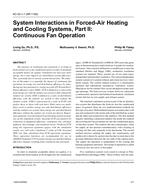Description
The purpose of continuous fan operation is to bring in fresh outdoor air to the conditioned space in order to maintain acceptable indoor air quality. Ventilation not only uses more energy, but it also impacts air distribution system efficiency. This is partially due to various system interactions. The objective of this paper is to quantify the impact of continuous fan operation on energy use and distribution efficiency by introducing two new parameters: energy use ratio (EUR) and distribution efficiency ratio (DER). EUR is defined as a ratio of the total energy use with the outdoor air system to that without the outdoor air system. DER is defined as a ratio of distribution efficiency with the outdoor air system to that without the outdoor system. DER is represented by a ratio of EURs with perfect ducts to those with real ducts. Both ratios are multipliers used to predict energy use and distribution efficiency with the outdoor air system when energy use and distribution efficiency without the outdoor air system are known. Regression equations were developed by performing statistical analysis on the simulation results. Seasonal EUR was found to be a function of equipment efficiency, ventilation rate, envelope tightness, duct leakage, and insulation levels. Predicted EUR using the regression equations agrees with the simulation results very well with a minimum r2 value of 0.96. Seasonal DER was then calculated from EUR regression equations. These regression functions are recommended for use in ASHRAE Standard 152P to predict energy use and distribution efficiency changes resulting from continuous fan operation.
Units: SI
Citation: Symposium, ASHRAE Transactions, vol. 109, pt. 2, Kansas City, 2003
Product Details
- Published:
- 2003
- Number of Pages:
- 9
- File Size:
- 1 file , 470 KB
- Product Code(s):
- D-18806




